Hello Interactors,
Our family hit a snag in the transportation department last week. Our routine was disrupted making us scramble for remedies — including possibly needing a new car. It all came at a time when the state of Washington released its 2021 figures on automobile related deaths. It made me wonder and reflect on car dependency, the Covid funk, and the psychology of cars.
As interactors, you’re special individuals self-selected to be a part of an evolutionary journey. You’re also members of an attentive community so I welcome your participation.
Please leave your comments below or email me directly.
Now let’s go…
CHITTY CHITTY BANG BANG
“It’s making a strange noise, shifts awkwardly, and smells funny,” my son and daughter exclaimed. There had been similar reports previously, but things had worsened. “It seems ok on the straights, but sounds and feels worse going down hill,” they added. Then, as my daughter got in the car to go to swim practice, she soon came back inside and said, “I’m taking the other car. Uno is making an awful noise and smells even worse than before.”
Our kids call our 2006 Audi A3, Uno. The Washington State Licensing authority named it when it was born. They even sent us two rectangular plates with its name stamped into it, along with a few appended random numbers. We mounted one on its nose and the other on its rear-end. Our kids use Uno to commute to school 12 miles away as well as other errands, appointments, and events. They both have a bit of an emotional attachment to this aging little black hatchback. Uno even becomes Dracula during Halloween when they affix dangling white fangs on each side of the license plate frame.
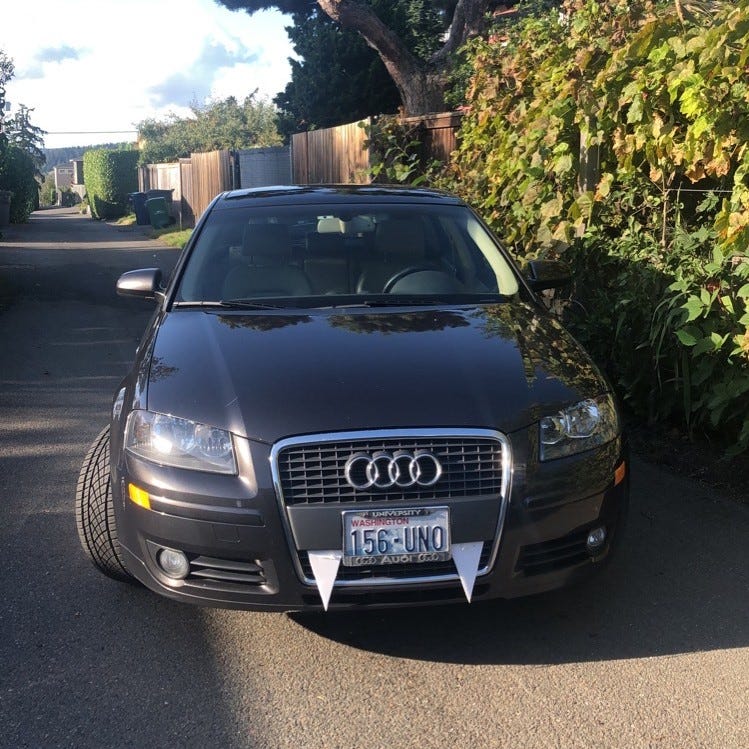
I’ve had an emotional attachment to Audi’s since I was a kid. I saw my first Audi in the mid-70s. It was Audi’s first car sold in the United States – The Audi Fox. A guy down the street owned one. His name was Delbert Woody. I was drawn to Delbert. He was a World War II veteran who personified the post-war male mystique. He rode a dirt bike in the open field behind his house, was an avid hunter and fisherman, drove construction trucks for a living, was a life long Teamster Union member, and loved pecan pie and Pepsi. He, like so many other war veterans, got married after the war and settled in the suburbs. They were the first to move into one of Norwalk, Iowa’s first subdivisions in 1960. Their single story ranch house, nestled neatly in a line of others just like it, sat on a hill below the water tower at the edge of town on a street aptly named: Edgemont.
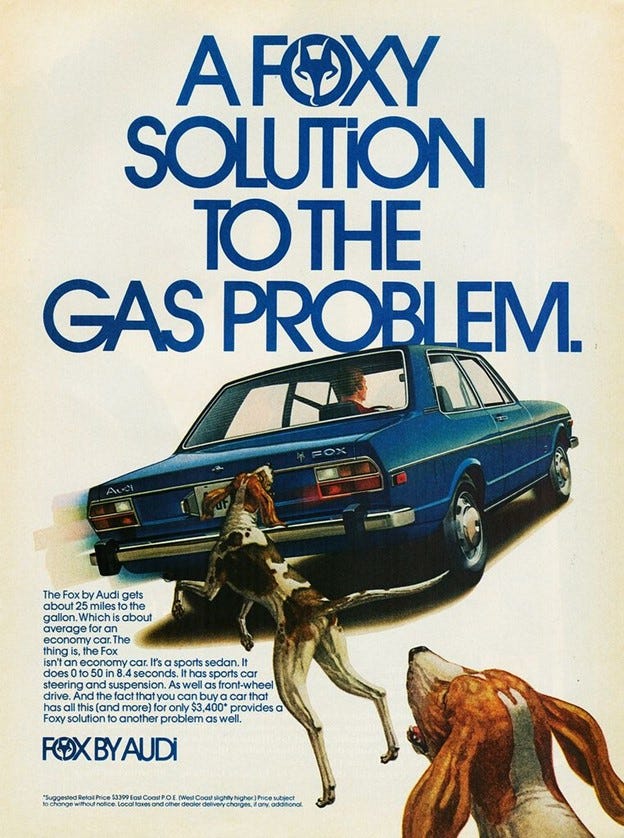
Also in keeping with post-war tradition, he had a fascination with cars. I remember him owning more than one and this was during the 1970s gas crisis and recession. Audi entered the U.S. market selling the Fox as a ‘solution to the gas problem.’ The Fox was marketed as a sports sedan with a sporty suspicion, front-wheel drive, and an engine that could get 25 miles to the gallon. All for $3400. That’s roughly $20,000 today. I can see how a masculine blue collar gearhead like Delbert was attracted to this car, despite it being German.
I’m not sure what I liked about it. Maybe it was the novelty of a foreign car in small Iowa town, the European styling, or maybe it was the cool fox emblem on the back. Probably all the above. The truth is, Delbert and I, and all auto-dependent motorists, share something in common. We all have brains that contain two separate modules that combine to form relationships with automobiles.

One of these cranial circuits uses cool calculating rational thought that views a car as a utility – an appliance. It’s sensitive to numbers: miles per gallon, range, price, 0-60, reliance ratings, and a myriad of other self-justifying statistics. The other side of the brain tugs on our heart strings. Emotional affections warm our heart in the comfort of a climate controlled cocoon. It makes our heart go pitter patter with the status cars provide, or cause our pulse to quicken at the sudden and effortless acceleration through space.
Both of these neuro-negotiators conspire to construct our comforting and sometimes conniving relationships with cars. And automakers have learned how to manipulate both of these brainy battles through design and marketing.
Uno got its name from a random license plate generator, but automakers are less random. For Delbert Woody’s Audi Fox, Audi wanted to associate that car with a fox. A fox is agile, strong, fast…and cunning. Many animals are. Which is why it’s not hard to find cars named after animals. Here are just a few: Plymouth Barracuda, Mercury Sable, Buick Skylark, Corvette Stingray, Pontiac Sunbird, Ford Thunderbird, Dodge Viper, AMC Eagle, Chevrolet Impala, and who can forget the Ford Pinto.
As you can see all of these are American made cars. U.S. automakers also like aggressive macho sounding names. Especially Dodge, with names like Challenger, Ram, and Avenger. Europe and Japan have a few examples like the Fiat Spider or Suzuki Samurai, but nothing like the U.S. You may be thinking to yourself, what about the iconic Volkswagen Beetle? Sorry, but that’s a nickname. It’s official name in Germany was Volkswagen Type 1. What about the Volkswagen Rabbit? It was the Volkswagen Golf in Europe. And Delbert’s Audi Fox would have been called the Audi 80 anywhere else but America.
The design of vehicles are also expressive. When Uno dawns his fangs at Halloween, the gimmick only works because the headlights make the eyes and the grill its mouth. Different cars take on different personalities when viewed from the front, or more commonly, when viewed in your rear view mirror. There’s speculation by some psychologists that these personalities may even be reflected in the owners and their driving behavior. There is certainly evidence that some car design and some drivers have become more aggressive over time. But it’s equally true that some aggressive looking cars are sometimes driven by passive people. Or maybe they’re using the design of their vehicle to hide or express some other hidden or deep seeded emotion or personality trait.
RAGE DISPENSED THE MACHINE
Stefan Gössling is a professor of social science at Lund University in Sweden. He researches and writes extensively on transportation. In 2017 he released a book called The Psychology of the Car. He says there are a wide range of emotions that relate to the power and dominance that play a central role in car culture. He cites research affirming “that driving powerful cars is generally understood as a means of expressing macho personalities.” Driving a powerful car exudes superiority and control.
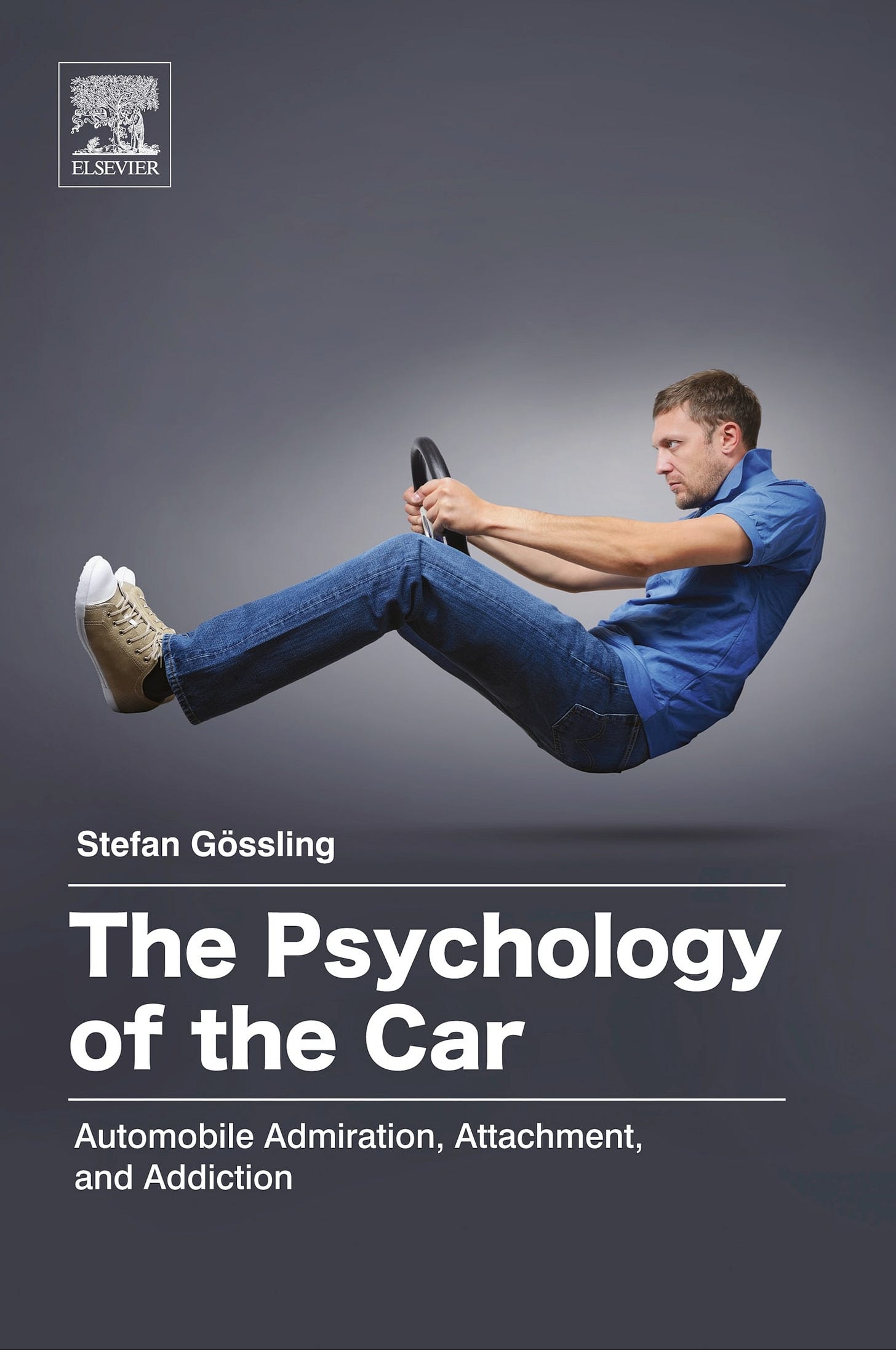
He lists different aspects and levels of control we have driving cars:
Agency: To be able to decide when to leave at any point in time, and for any given destination
Semiotics: Being in charge: control of inside (music, temperature) and outside environment (navigation system, speed), and car physics (fuel levels, revolutions per minute)
Haptics: Holding the steering wheel, pushing pedals, shifting gears
Smells and soundscapes: Choice of smell or music, interior
Physics of movement: Being able to drive fast, to accelerate1
But he also quotes the sociologist, John Urry. He too wrote extensively on the sociology of mobility, especially regarding the loss of control that can come with controlling a fast moving machine. The automobile, while offering us much control, can also rob us of critical experiences. He writes,
“Dwelling at speed, car-drivers lose the ability to perceive local detail, to talk to strangers, to learn of local ways of life, to stop and sense each different place. Sights, sounds, tastes, temperatures and smells get reduced to the two-dimensional view through the car windscreen and through the rear mirror, the sensing of the world through the screen being the dominant mode of contemporary dwelling. The environment beyond that windscreen is an alien other, kept at bay through the diverse privatizing technologies incorporated within the car. These technologies ensure a consistent supply of information, a relatively protected environment, high quality sounds and increasingly sophisticated systems of monitoring. They enable the hybrid of the car-driver to negotiate conditions of intense riskiness on high-speed roads.”2
Our roads are designed to drive at high speeds. They even include optical illusions to put you at ease. For example, the length and distance between dashed lines on highways are designed to trick your brain into believing your body is moving slower than it really is. And while there have been many amazing safety advancements in the engineering of roads and cars for those inside the vehicle, they’ve inadvertently made them increasingly dangerous for those outside of the vehicle.
Washington state ended 2021 with the highest number of road fatalities in 15 years. There were more than 540 fatal crashes killing over 600 people. One hundred and eighteen of whom were walking or riding their bike. An additional 2,411 crashes were estimated to have caused serious injury – a 16% rise over 2020. Thirty one people were killed in Seattle alone in 2021.

While the design of our infrastructure and vehicles encourages speed, other factors are at play as well. Alcohol and drug related crashes have continued to climb 25% since 2019. Speed also was a major factor climbing 18% since 2020.
There are a multitude of interrelated factors that lead to increasing numbers of motorists killing and injuring people – especially cyclists and pedestrians. But given the social malaise that has overcome us all over the last few years, anger and aggression are likely key factors. Whether it’s lockdown lunacy, income inequity insanity, racial reality, gender gut checks, or fights between the lefts and the rights there are ample reasons for us all to be disturbed.
There are also threats to the status quo. Increasingly cities are seeing bike and bus lanes squeezing out car lanes, rising gas prices, and talk of congestion fees. Meanwhile, automakers are ditching the traditional internal combustion engine for progressive green machines. These are levels of social change that many welcome, while others reject – especially those adverse to change or who feel their individualism is threatened.
So they take it out on others on the road. We’ve all witnessed, or are guilty of perpetrating, acts of aggression on the road: dodging and weaving through traffic, tailgating, flashing lights, running red lights, honking, flipping the bird, or yelling out the window. Worse yet, extreme forms of road rage where people take chase in a fit of anger to inflict harm or intimidation. There are more passive aggressive examples too, like parking in a bike lane, stopping in a cross walk, or failing to yield to a blinkering merging bus.
In 1994, Jerry Deffenbacher, a Colorado State psychology professor who studies correlations of anger and anxiety with behavior, created a Driving Anger Scale that scientists have been using since. Results as recent as 2016 suggest personality traits like “impulsiveness, narcissism, and normlessness” confirm studies from 2013 that link narcissism to aggressive driving. One researcher concluded:
“driving anger of narcissistic individuals may result out of threats to perceived power, control, and position rather than to image and attention seeking.”3
Results also vary by age, gender, driver experience, and culture. In a country who’s culture flaunts and breeds narcissism, individualism, and macho maleness – possibly even overly tolerant of outward expressions of anger as an acceptable emotional response – we should not be surprised to see increased aggression on the part of some motorists.
Sometimes anger directed at strangers can take the form of contempt. The car then becomes a way to separate one’s self from others deemed inferior or from an anxiety inducing changing environment. Here’s how one geography researcher, Jason Henderson of San Francisco State University, described an SUV driver in a 2006 study looking at the politics of automobility in Atlanta, Georgia.
“After spitting into a toll collection device on the highway, the angry white male described his disdain at the possible alternatives to his SUV — a compact urban form with intensive transit infrastructure containing pedestrian and transit spaces where people would have physical proximity to ‘others’ of different racial, class, gender or sexual orientation. Seen in this context, his SUV was more than just an instrument for traveling through the city. It was an instrument of secession from what he scorned in contemporary American urban space.”4
WITH URBAN FRICTION COMES CAR ADDICTION
We took Uno to the doctor. We had a sneaking suspicion it may be done for. When my wife pulled into the shop they said, “You best turn that off, it doesn’t sound good. You probably should have had it towed.” But after waiting a few days for the prognosis, it turned out to be a couple bad spark plugs, failing coils, and noise inducing broken catalytic converter.
When my son heard this news, he said, “Let’s straight-pipe it!” Straight-piping is when you remove emission reducing mechanisms so that the sound, and pollution, from the engine goes straight out the tailpipe. Both my son and my daughter have an affinity for loud cars. My son can tell you the make and model of a car just from the sound of the exhaust. He’s a combusting carbon connoisseur. And lucky for him, there seems to be an increasing number of loud tailpipes these days.
I’m more aghast at the uproarious racket. I grumble and mutter under my own exhaust as these cars rumble by, “There goes another UAS. Urban Attention Seeker.” And it seems I’m right. Overly loud modified exhausts, or even some motorcycles (I’m looking at you Harley Davidson), are symbols of rebellion. They signal to anyone in ear shot opposition to authority and social norms. They scream, “NOTICE ME!”
In Gössling’s book he cites the research of Robert Merton who is regarded by many as the founder of modern sociology. He also studied criminology where he developed strain theory which says strain in an individual can come about in a society that pressures people to attain more than they can possibly achieve. So they seek forms of rebellion. More recent advances in this theory by the criminologist and social psychologist Robert Agnew point to three factors that lead to criminal acts of rebellion. They largely stem from childhood stress, trauma, victimization, and neglect:
The inability to achieve positively valued stimuli
(e.g., money, status, autonomy)The loss of positively valued stimuli
(e.g., loss of romantic partners, property)The presentation of negatively valued or aversive stimuli
(e.g., verbal and physical abuse)5
But loud cars, or motorcycles, can just as easily be driven by financially successful people at the top of the social status hierarchy. These are the cars my son most admires. They’re hyper or super cars made by companies like Lamborghini, Ferrari, or Mercedes Benz. One of his favorites is the throaty land yacht by Mercedes Benz – The G Wagon. These are less emblems of rebellion and more signals of status. Both are forms of attracting attention.
And so is an Audi A3. Even though it was the cheapest car Audi sold at the time, it is still a luxury German automobile. And while it is a brand I dreamed of owning since childhood, I can’t deny my purchase also helped to signal my status. If my rational brain had one out, and I viewed the purchase of the car as an appliance for mobility, I could have easily put myself into a more affordable hatchback. As one friend put it, the A3 is really just a Volkswagen Golf for grown ups. Works for me.
We decided to keep Uno in the family. And sorry, son, Uno won’t be straight-piped. It’s getting a new catalytic converter…even though replacing it will cost more than the car is worth. This is the last year our kids will be driving Uno to school together and they want that little car to be a part of it.
Our kids could ride a public bus to school, but it takes an hour to go 12 miles and they have afterschool activities at locations far and wide. My son took the bus for a year and it left him exhausted with little time for homework. We chose to put them in this school, but we didn’t chose the car dependent design of our surrounding cities.
When it comes to car dependency, it turns out there really are two sides of the brain at work; one rational and one emotional. Gössling breaks them down into ‘real’ and ‘perceived’ dependencies. ‘Real’ dependencies are like what I just described. There are aspects of urban planning and design that intentionally require people to have a car to live a modern, happy, healthy, and productive life. The car is an appliance that gets you to the doctor, practice facility, grocery store, or school on time – places that require a car and are practically inaccessible by anyone who cannot or choses not to drive a car.
‘Perceived’ dependencies are rooted in fears and emotions where, as Gössling says,
“alternative transport is considered ‘dysfunctional,’ i.e., creating anxieties related to complexity (buying tickets, finding ways), claustrophobic spaces, monitoring in ‘militarized’ environments (control, security), encounters with marginalized people (homeless, alcoholics, drug addicts), or specific smells and noises. Car use may also be related to status, fright-flight-fight responses, or other fears and phobias. In such situations, car reliance may be considered an addiction.”6
Automakers feed this addiction through advertising, marketing, and design. As Gössling summarizes in his list of car industry appeal strategies. I can imagine these being whispered seductively to the emotional side of our brain:
The car will be good:
The car is increasingly less polluting and safer in trafficThe car is your home:
Home and car melt into one spaceThe car is your partner:
You are a more capable person in cooperation with your carThe car will protect you:
It is a dangerous worldYou need the car:
Appeals directed at subconsciousBe aware of government:
Someone is trying to take away your car7
I for one am ready to break the addiction. Who knows, once our kids leave the house for college, maybe it will be time for Uno to graduate too. That someone trying to take away the car may just be me. Unless, of course, Audi releases an electric retro Audi Fox!
Stefan Gössling. The Psychology of the Car: Automobile Admiration, Attachment, and Addiction. Elsevier. 2017.
Ibid.
Ibid.
Ibid.
Ibid.
Ibid.
Ibid.

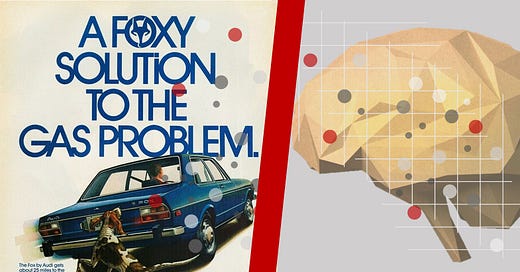










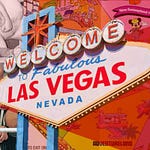


Share this post